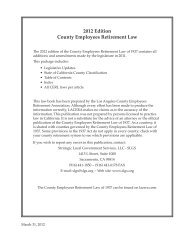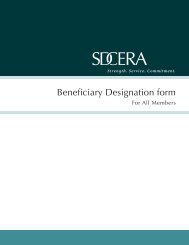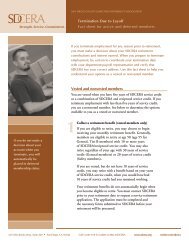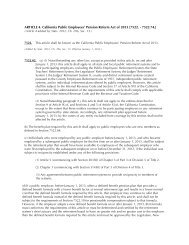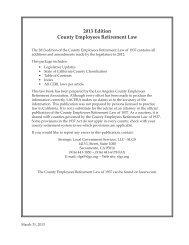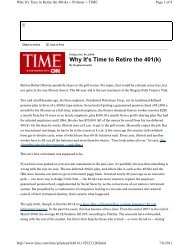CAFR - sdcera
CAFR - sdcera
CAFR - sdcera
You also want an ePaper? Increase the reach of your titles
YUMPU automatically turns print PDFs into web optimized ePapers that Google loves.
I N V E S T M E N T S / C H I E F I N V E S T M E N T O F F I C E R ’ S R E P O R T<br />
TRUSTEES, BOARD OF RETIREMENT:<br />
For the fiscal year ending June 30, 2007, the markets remained focused on fluctuating oil<br />
prices, rising interest rates, widespread woes in the sub-prime lending arena, and a general<br />
uncertainty as to the future direction of the market. Rising interest payments and declining<br />
home prices led to numerous sub-prime mortgage defaults, and ultimately widened the spreads<br />
on asset-backed securities (ABS). The price of oil dropped significantly during the third and<br />
fourth quarter of 2006, reaching $50.51 per barrel in January, before rebounding and closing<br />
at $70.47 on June 29, 2007. The Federal Open Market Committee (FOMC) met 8 times during<br />
the fiscal year but kept its target for the federal funds rate unchanged at 5.25%.<br />
Real GDP rose 1.9% during the year compared to 3.6% for the prior year. Strong consumer<br />
spending and positive GDP growth in the third and fourth quarters of 2006 were negated by<br />
a below-trend rate of growth in the first quarter of 2007. The primary drivers of first quarter<br />
2007 performance were the meltdown in the U.S. housing market and a market correction<br />
beginning in China that stretched across the globe. Inflation decreased significantly during this<br />
period as the CPI was 2.7% versus 4.3% for this same period one year ago. Reduced<br />
inflation worries in the first half of the fiscal year drove this decrease. Excluding food and<br />
energy, the CPI ended the period at 2.2%.<br />
The U.S. stock market generated positive returns across the different market caps (large,<br />
mid, and small) and investment styles (growth and value). The S&P 500 Index returned<br />
20.6% for the year compared to a return of 8.6% for the same period last year. Most value<br />
stocks had higher returns than growth stocks over the entire fiscal year; however, growth<br />
stocks outperformed value stocks during the final two quarters. There was also a shift<br />
in market cap performance with large cap stocks outperforming small cap stocks, as the<br />
Russell 2000 Index earned 16.4% during this period.<br />
Global economic growth, high commodity prices, and increased liquidity helped non-U.S. markets<br />
continue to outperform the U.S. market for the fiscal year period. Performance was driven by<br />
strong returns in the Latin American region due to the rising value of regional currencies and<br />
continued economic growth. The Morgan Stanley EAFE Index, excluding the U.S., returned 27.0%.<br />
During the twelve months to June 30, 2007, the MSCI Emerging Markets Index generated a return<br />
of 45.0%, up from a 35.9% return over the same period last year. International small cap stocks<br />
generated strong returns as well, as the MSCI EAFE Small Cap returned 25.2% for the period.<br />
46 COMPREHENSIVE ANNUAL FINANCIAL REPORT 2007



